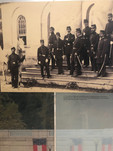Arlington National Cemetery Sep 18, 2019
- alainaa2

- Oct 13, 2019
- 10 min read
We had this one day here and I had always wanted to go see this one place and finally I got to go see it.

of course its free to get in but you have to pay for parking we tock a uber so I don't know how much the is but

I have alway's wanted to come here to pay my respects to those who have the honer to rest in peace here. For me it is a sobering visit, of course this is hallow ground, and need to keep in mind to show respect to the dead. When I married and because a military wife my out look change, it is always changing by the experiences you have. The only other place I truly understood this part to the full measure of the meaning was at Pearl Harbor standing on the memorial over the USS Arizona.
Our first stop was to find out what section and plot number my husband's roommate/classmate was laid to rest at so we could go pay our respects to him.
{A coin left on a headstone let's the deceased soldier's family know that somebody stopped by to pay their respect. Leaving a penny means you visited. A nickel means that you and the deceased soldier trained at boot camp together. If you served with the soldier, you leave a dime. As visitors walk through Arlington National Cemetery en route to the Tomb of the Unknowns or John F. Kennedy's grave, they often ask why rocks are atop tombstones. Simply, it's a Jewish tradition. Rocks serve as a reminder of one's visit to a grave much like Christians leave flowers. ... The rock tradition has spread.
If I remember right once a month every thing gets taken off the tombstones and but in a book and put when they pick them up and stored at a off sight facility the family members can go and see what people have left for their love one.}
Did You Know:
Arlington is the only national cemetery to hold service members from every war in U.S. history.
Although the first military burial at Arlington National Cemetery didn’t occur until 1864, the burial ground holds the remains of those who fought in every war since the American Revolution. In 1892, soldiers killed in the Revolutionary War were reinterred from a Georgetown cemetery, and casualties from the War of 1812 have been reburied at Arlington as well.
After we got back we got on the tram. We saw a lot of amazing people who rest here, and their amazing stories
The Hemicycle and the Schley Gates
The last photo is one example of the Schley Gate, there are two ceremonial gates at the entrance to the cemetery.
The gates were constructed in 1932 as part of the construction of the Hemicycle (now the Women in Military Service to America Memorial), and Memorial Drive which linked Arlington's new main gate to the Arlington Memorial Bridge and the George Washington Memorial Parkway.
Arlington had expanded toward the Potomac River, making the old McClellan Gate and Sheridan Gate unuseable as an entrance as both were now deep inside the cemetery. Each gate consists of four granite pillars trending southwest-to-northeast. The southwesternmost pillar connects with the retaining wall that forms the Hemicycle.
The gate itself is between the second and third pillars, while black wrought iron fences connect the outermost pillars to the innermost ones. A fifth pillar is set inward toward Memorial Drive from the northwesternmost pillar, and is connected to the fourth pillar by a black wrought iron fence. The two innermost pillars are topped by granite eagles, while the other three are topped by decorative funeral urns.
The Schley Gate is open for the public. To the left is the northwestern-most pillar topped by an urn.
Gold gilded lamps top the hinge of each gate. On each gate, front and back, are two gold wreaths 30 inches in diameter. Each wreath cradles the shield of the U.S. Department of War aka the precusor to the U.S. Department of Defense, as well as the armed services that existed in 1932. On the Schley Gate, these are the United States Navy and United States Coast Guard. The United States Air Force did not exist until 1947. Each gate is divided into 13 sections by wrought iron fasces, and above six of the sections are iron spikes topped by gold stars.
John F. Kennedy our 35th President gave with Arlington house in the background.
This grave is the single most visited site in Arlington. On Nov 25,1963 our 35th President of the United States of America was laid to rest on the hillside, the Eternal Flame was lit by his widow Jacqueline at his burial service. Two of their infant children one a boy Patrick and girl Arabella both died before their father assassination and were relocated on either side of him on Dec 4 1963. Jacqueline passed away on May 19, 1994 and was buried alongside her husband President Kennedy.
Did you know:
The cemetery didn’t gain a national reputation until after the burial of President John F. Kennedy.
After his assassination in 1963, President Kennedy’s body was expected to be buried in at the Kennedy family plot near Brookline, Mass. But after First Lady Jacqueline Kennedy stated her husband belonged to the people, a burial plot in Arlington Cemetery just below Arlington House aka General Lee’s old mansion was prepared. Nine days after President Kennedy’s funeral (which was based on President Abraham Lincoln’s) .
The Kennedy burials sparked a rapid increase in burial requests. Previously, burials on the government’s dime were granted for all honorably discharged U.S. veterans. After requests ramped up, eligibility was first limited in 1967 and again in 1977. When the couple’s son John F. Kennedy Jr. and his wife Carolyn died in a plane crash off the coast of Martha's Vineyard in 1999, their body's where cremated and the ashes were scattered over the Atlantic Ocean near the spot they died.
The Tomb of the Unknowns
I have heard and saw videos of the changing of the guards and standing here in the silent's is nothing I have ever experience before. The calm passing off time and the view just adds to the rich traditions of protecting the unknowns is an uplifting and moving felling in your hart as you stand there and take everything in.
The tombs of the unknown serviceman from every war in American History execpt for the American Revolution. The official tomb of the unknowns for the Revolutionary was is located in the burial grounds of the Presbyterian Meeting House in Alexandria, Va.
There is so many stories that I can not tell you but for you to come and see for your self I want to go back to see and remeber all the amazing people who rest here story of there lives. There is a amazing book that tells these stories. I got mine in the gift shop. Arlington National Cemetery: Shine to American's Heroes by James E. Paters
The Arlington Museum and artifacts on display:
Other monuments and graves wish we could have had more time here to pay proper respects but we got gaining latter than we thought and I know we will be back to see, learn, and honer our fallen.
After our amazing day we had dinner with friends before we head back to the hotel and flying back home the next day.
Have you ever wondered how Arlington got its name and the history of this place. If so please keep reading if not thank you and see you with next post.
I did not know any of its rich History. They don't teach it in schools.
The mansion, which was intended as a living memorial to George Washington, was owned and constructed by the first president's step-grandson, George Washington Parke Custis, son of John Parke Custis who himself was a child of Martha Washington by her first marriage and a ward of George Washington.
The name 'Arlington' won out over 'Mount Washington,' which is what George Washington Parke Custis first intended calling the 1,100-acre tract of land that he had inherited at the death of his father when he was an infant. Arlington was the name of the Custis family ancestral estate in the Virginia tidewater area.
Custis hired George Hadfield, an English architect who came to Washington in 1785 to help construct the U.S. Capitol, to design his estate. The Greek revival structure which Hadfield designed took Custis sixteen years to complete. The north wing was the first structure completed in 1802. It was in this building that Custis made his home, with a significant portion of it used to store George Washington memorabilia that Custis was acquiring with regularity. Among the items purchased and stored in the north wing were portraits, Washington's personal papers and clothes, and the command tent which the president had used at Yorktown.George Washington Parke Custis and his wife, Mary Lee Fitzhugh whom he had married in 1804, lived in Arlington House for the rest of their lives and were buried together on the property after their deaths in 1857 and 1853, respectively. They are buried in what is now Section 13.
On June 30, 1831, Custis' only child, Mary Anna Randolph Custis, married her childhood friend and distant cousin, Robert E. Lee. Lee was the son of former three-term Virginia Governor Henry Lee and was himself a graduate of West Point. Under the terms of her father's will, Mary Anna Custis Lee was given the right to inhabit and control the house for the rest of her life. Custis' will also stipulated that upon Mary Anna's death, full title would pass to her eldest son, George Washington Custis Lee. Contrary to popular belief, Robert E. Lee never owned the Arlington estate. Lee did serve as custodian of the property until George Washington Custis Lee would inherit the land when his mother pass away.
Robert E. Lee resigning from the U.S. Army on April 20, 1861, days later he toke command of Virginian forces in the Civil War, Robert E. Lee left the Arlington estate where he had married Mary Lee and lived for 30 years. He would never return. After Virginia seceded from the
Union on May 23, 1861.
On May 24, 1861, just a few hours after voters of the Commonwealth of Virginia ratified an ordinance of secession, thus joining the Confederate States of America, over 3,500 U.S. Army soldiers, commanded by Brig. Gen. Irvin McDowell, the Union troops crossed the Potomac River from the national capital and occupied Arlington estate.
Although many believed the occupation of the estate was an intentional insult towards the Lee family, in reality the confiscation of the property was a military necessity. Arlington House, located on Arlington Heights, the high ground overlooking Washington, D.C., and it posed a tempting target for Confederate forces. Mid-19th-century artillery, situated on this elevated terrain, could easily range every federal building in the city, including the White House and Capitol. Throughout the war, federal troops used the land as a camp and headquarters with forts constructed and incorporated into the defenses of Washington, DC, including Fort Whipple now known as Fort Myer, and Fort McPherson now Section 11on the property.
Lee deeply regretted the loss of his home at Arlington. During the early stages of the war, foreseeing the probable loss of his home and belongings, Lee wrote to his wife about Arlington:
'It is better to make up our minds to a general loss. They cannot take away the remembrance of the spot, and the memories of those that to us rendered it sacred. That will remain to us as long as life will last, and that we can preserve.'
After Mary Lee was confined to a wheelchair, she sent a representative instead of appearing personally to pay a $92.07 tax bill, the government seized the property in 1864. The federal government confiscated the property when Mrs. Lee failed to pay, in person, taxes levied against Arlington estate. Offered for public sale on January 11, 1864, a tax commissioner purchased the property for 'government use, for war, military, charitable and educational purposes.
It was not until 1864, when the increasing number of battle fatalities was outpacing the burial capacity of Washington, D.C., cemeteries that Quartermaster General Montgomery C. Meigs formally proposed Arlington as the new location for military cemetery. On May 13, 1864, 21-year-old Private William Christman of Pennsylvania, who had died of peritonitis, became the first military man buried at Arlington.
Upon the authority of Secretary of War Edwin Stanton, appropriated the grounds on June 15, 1864, for a new military cemetery.
The intention given by Meigs was to render the house uninhabitable should the Lee family ever attempt to return. To ensure the house would forever be uninhabitable for the Lees, Meigs directed graves to be placed as close to the mansion as possible, and in 1866 he ordered the remains of 2,111 unknown Civil War soldiers killed on battlefields near Washington, D.C., to be placed inside a stone and masonry burial vault 20 feet wide and 10 feet deep (in the Lee's rose garden) and containing the remains of 2,111 war casualties, was among the monuments to Union dead erected under Meigs' orders.Meigs himself was later buried within 100 yards of Arlington House with his wife, and son – the final statement to his original order.
Throughout the war, Arlington estate also provided assistance to the thousands of African-Americans fleeing enslavement from the South. On December 4, 1863, the federal government dedicated a planned community for freed slaves. To assist former slaves transitioning to freedom. With housing, schools and healthcare. It became a home for several thousand former slaves who worked there as laborers for 10 dollars a month. Half of their salary went to maintaining the village. In addition to this general fund, residents were later asked to pay one to three dollars a month for rent. This fee, in addition to strict living policies, was considered burdensome and tensions between the federal government and the village cropped up as early as 1868. Residents formed their own government and advocated for compensation for work they had done to the property. They pushed back even after the community was evicted in 1900 to make room for burial plots. Residents eventually received $75,000 after a land appraisal.
Neither Robert E. Lee, nor his wife, as title holder, ever attempted to publicly recover control of Arlington House. The couple never returned to the home George Washington Parke Custis built and treasured. After Lee's death in 1870, his son, George Washington Custis Lee, brought an action for ejectment in the Circuit Court of Alexandria (today Arlington) County, Va. Custis Lee, as eldest son of the Lees, claimed the land was illegally confiscated and that, according to his grandfather's will, he was the legal owner. In December 1882, the U.S. Supreme Court, in a 5-4 decision, returned the property to Custis Lee, stating that confiscation of the property lacked due process. On March 3, 1883, Congress purchased the property from Lee for $150,000. Arlington National Cemetery continued its mission as a military reservation and burial ground for United States service members and family.



























































































































































Comentarios